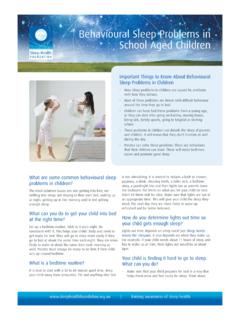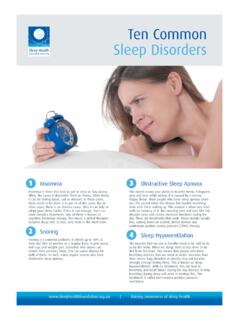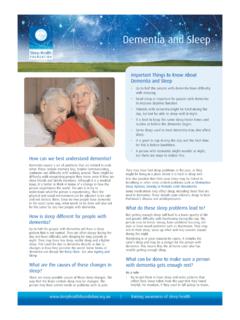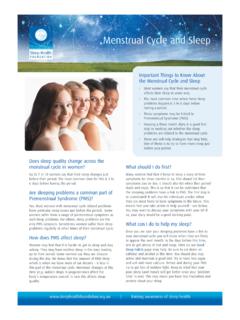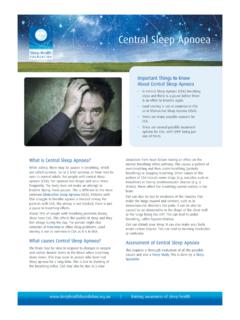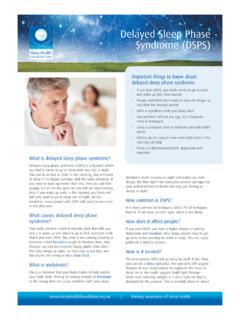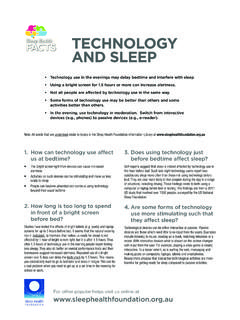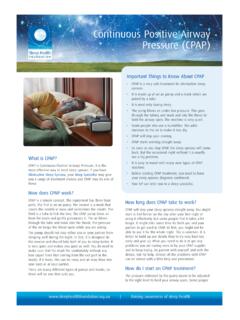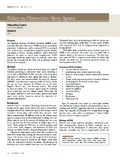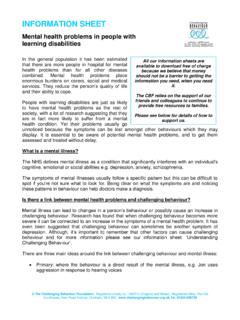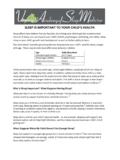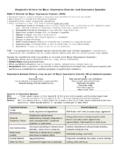Transcription of SLEEP NEEDS ACROSS THE LIFESPAN - Sleep …
1 SLEEP need gets less with age until around 20 years old when it stabilises. How much and how fast this happensdepends on the person. It is normal for children to have daytime naps until 3 to 5 years old. If a child takes naps often past this age, he orshe might not be sleeping enough at night. Teenagers will tend to want to go to bed later,and SLEEP in. Older people spend more time in bed, buttheir SLEEP requirement is normally similar tothat of early adult NEEDSACROSS THELIFESPANFor other popular helps visit us online at How do our SLEEP NEEDS change with age?
2 It is well known that as children get older they need less SLEEP . Different people have different SLEEP NEEDS . The advice in the table below is only aguide. You can make a good guess if a person is sleeping enough at night - observe how they act and function during the day. Note: All words that are underlinedrelate to topics in the SLEEP Health Foundation Information Library at AGE RECOMMENDED MAY BE APPROPRIATE NOT RECOMMENDED Newborns 14 to 17 hours 11 to 13 hours Less than 11 hours 0-3 months 18 to 19 hours More than 19 hours Infants
3 12 to 15 hours 10 to 11 hours Less than 10 hours 4-11 months 16 to 18 hours More than 18 hours Toddlers 11 to 14 hours 9 to 10 hours Less than 9 hours 1-2 years 15 to 16 hours More than 16 hours Preschoolers 10 to 13 hours 8 to 9 hours Less than 8 hours 3-5 years 14 hours More than 14 hours School-aged Children 9 to 11 hours 7 to 8 hours Less than 7 hours 6-13 years 12 hours
4 More than 12 hours Teenagers 8 to 10 hours 7 hours Less than 7 hours 14-17 years 11 hours More than 11 hours Young Adults 7 to 9 hours 6 hours Less than 6 hours 18-25 years 10 to 11 hours More than 11 hours Adults 7 to 9 hours 6 hours Less than 6 hours 26-64 years 10 hours More than 10 hours Older Adults 7 to 8 hours 5-6 hours Less than 5 hours 65 years
5 9 hours More than 9 hoursThe above SLEEP duration recommendations are based on a report of an expert panel convenedby the US based National SLEEP Foundation and published in 2015 in their journal SLEEP Health Foundation114/30 Campbell Street, Blacktown NSW 2148T: +61 (0) 2 8814 8655 F: +61 (0) 2 9672 How does napping changewith age?From birth to two months of age, the length of one period of SLEEP canbe from 30 minutes to 3-4 hours. This is throughout the day and fed from the bottle tend to SLEEP for longer at a time thanbreast-fed babies (3-4 hours versus 2-3 hours).
6 See also Tips to HelpBabies SLEEP 2 months onwards babies start to SLEEP for longer at a time. Thisis especially so at night between 12 midnight and 5am. The reason forthis is that they start to develop their internal day-night (circadian)rhythm that favours SLEEP at night and being more awake during 6 months of age, babies can get 5 8 hours of SLEEP at 25-50% of 6 month olds still wake up at night. There arethings that can be done to counteract this including ensuring that theylearn to go to SLEEP in their cot by themselves at the start of the they are more able to self-soothe themselves back to SLEEP afterwaking up during the 2 months to 12 months, the number of daytime naps goes downfrom 3 - 4 naps to two naps.
7 Morning naps usually stop between 12and 18 months of give a chance for an afternoon nap after lunch and before naps become less common from about 2 or 3 years daytime naps after 5 years of age are not normal. The childmight not be getting enough SLEEP at night. This may be due to poorsleep routines, SLEEP problems or SLEEP disorders. It may need to befollowed up with a SLEEP also Behavioural SLEEP Problems in School Aged Childrenand/orChildren s SLEEP Why do teenagers want to stayup later?In this age group, there is a change in the timing of SLEEP .
8 It is naturalfor them to want to go to bed later at night and to SLEEP in. Howeverthis should be within reason and teenagers often need to be taughtgood SLEEP habits. They need to know that they won t function as wellduring the day if they miss SLEEP and fail to catch up on it. See alsoTeenage Adult sleepSleep requirements stabilize in early adult life, around the age of vary in their SLEEP NEEDS but most adults require between 7and 9 hours a night to feel properly refreshed and function at their bestthe next day. Many try to get away with less SLEEP .
9 There are some whoare genuine short sleepers while others may require considerably morethan the average requirement. The reasons for this individual variabilityin SLEEP requirement are not well adults spend more time in bed but unless a SLEEP problem hasdeveloped the requirement for SLEEP is similar to that in their youngeradult life. 5. Where can I find out moreabout SLEEP NEEDS ACROSS thelifespan? information is produced by: SLEEP Health FoundationABN 91 138 737 national organisation devoted to education, advocacy and supporting research into SLEEP and its - Information provided here is general in nature and should notbe seen as a substitute for professional medical advice.
10 Ongoing concernsabout SLEEP or other medical conditions should be discussed with your localdoctor. SLEEP Health Foundation, 2015 Version 1: created September 2011 / Version 2: updated February 2015 For information on over 60 different SLEEP relatedtopics, written by professionals, visit the SleepHealth Foundation Information Library The underlinedtopics in this article are covered in detail there.
